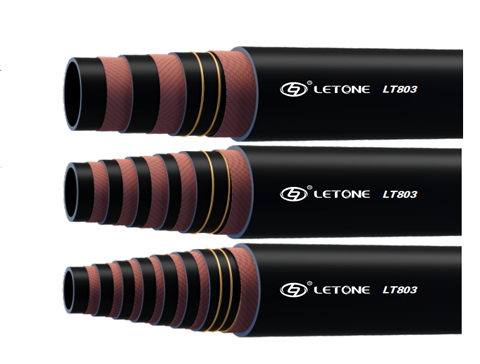SAE 100R3 is a low-pressure hydraulic hose standard developed by the Society of Automotive Engineers (SAE) in the United States, specifically designed for conveying petroleum based hydraulic oils, lubricants, and media such as water ethylene glycol. Its applicable pressure range covers 3.5~21 MPa, and the working temperature spans from -40 ℃ to+100 ℃, suitable for engineering machinery, agricultural equipment, and industrial hydraulic systems. This hose must meet the mandatory requirements of SAE J517 standard for pulse life (≥ 200000 cycles) and burst pressure (≥ 4 times the working pressure), and is a classic solution for general hydraulic transmission scenarios.
Multilayer Composite Structures: Materials Science and Reinforcement Design
The SAE 100R3 hose adopts a three-layer composite structure: the inner layer is a mixture of oil resistant nitrile rubber (NBR) or chloroprene rubber (CR), which is formed by vulcanization to achieve medium barrier; The reinforcement layer is interwoven with high-strength polyester fibers or aramid fibers, providing axial and radial compressive support; The outer layer is covered with wear-resistant and ozone resistant CR rubber, with a thickness of ≥ 1.5mm to resist mechanical wear. For example, the 100R3 hose reinforced with aramid fiber can withstand a working pressure of 21MPa, and its fiber weaving angle accuracy needs to be controlled at 54 ° 44 '± 2 ° to balance flexibility and blast resistance.
Performance verification system: from laboratory to actual working conditions
SAE 100R3 hose needs to undergo rigorous testing to verify its reliability:
Pulse test: Apply pressure fluctuations at a frequency of 1Hz at 100 ℃ (peak pressure is 133% of the working pressure), continue until failure, with a requirement of at least 200000 cycles;
Low temperature bending test: Bend the hose to the minimum bending radius (about 5 times the pipe diameter) in an environment of -40 ℃ to verify that the adhesive layer has no cracks;
Chemical compatibility: According to ASTM D380 standard, soaking in IRM 903 oil for 70 hours requires a volume expansion rate of less than 25%.
This type of testing ensures the stability of the hose under extreme working conditions and meets international certification requirements such as ISO 18752.
Industrial scenario adaptation: cross domain application practice
SAE 100R3 hoses are widely used in the following scenarios:
Construction machinery: hydraulic pilot system for excavators and loaders, transmitting hydraulic oil with a pressure of ≤ 21MPa;
Agricultural equipment: hydraulic suspension system for tractors, capable of withstanding field vibrations and chemical corrosion (such as fertilizer residues);
Industrial lubrication system: Machine tool centralized oil supply pipeline, compatible with ISO VG32~VG68 grade lubricating oil.
In semiconductor equipment, 100R3 hoses treated with special cleaning processes can also be used for ultra clean hydraulic oil transmission, with particle contamination levels controlled below NAS level 7.
Maintenance optimization and lifespan extension strategy
The following principles should be followed to extend the service life of SAE 100R3 hoses:
Installation specifications: Avoid bending radius less than 5 times the pipe diameter to prevent stress concentration in the reinforcement layer;
Regular testing: Check the outer layer for cracks, hardening, or local expansion every 500 hours (replace if the diameter expansion is greater than 10%);
Environmental protection: UV exposure scenarios require the installation of protective sleeves, and chemical splash areas are enhanced with polyurethane coatings for protection.
Research has shown that adjusting the pre tension (controlling the stretching amount at 2%~4% during installation) can reduce the risk of pulse fatigue and increase the service life of hoses by 15%~20%.

